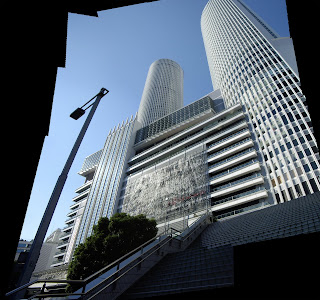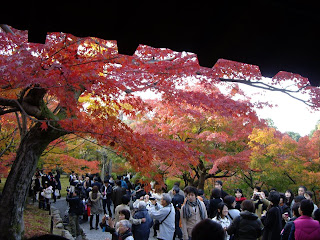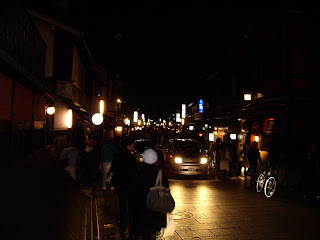
Another long weekend, another excursion somewhere into deepest darkest Japan. This time, Japan's cultural treasure and number one tourist destination - Kyoto. Very well preserved from the Edo period, as before this most of the city was destroyed in the civil wars, and having survived being target number one of the atomic bomb (removed from the target list by one of America's higher ups - apparently he honeymooned there), Kyoto is an interesting mix of old, traditional architecture and huge, sprawling modernity that comes with Japanese cities.
NB. You have to forgive some of the photos with this post. There are two things my camera doesn't like, and it had to put up with extremes of both: dark and bright sun. If you feed it any slight dimness whatsoever, it claims it wants a flash and when you don't give it one it sulks and blurs whatever photo you take. In bright sunlight it decides to either bleach everything or to miss out a colour or two. So, some of these pictures are edited to try and get the best out of what I took. Funnily enough, some of the best photos (in my opinion) on here were taken perfectly naturally, which goes to show it's not a bad camera after all.
 Koyo
KoyoThis trip to Kyoto was going to be with Lena, another exchange student, from Germany, and we would be meeting up with her old Japanese friend, Gen. Reachable from Nagoya by normal trains within two hours, en route it slowly started to become obvious that everyone around us was also going to Kyoto. At this I cottoned on that Japan's "koyo" season was really in full swing. "Koyo" is the very popular appreciation of leaves changing colour in Autumn, and of course there's no better place to fully observe and appreciate orangey leaves than in Kyoto, where you can see them alongside a lot of well known beautiful temples. This was most evident when we arrived at Kyoto station to find people everywhere and enormous queues for every bus, taking new-come tourists to various parts of sightseeing.

An interesting observation was that the overwhelming majority of the tourists were Japanese, aka domestic. I can't really imagine a similar situation of national vigour to appear in Britain, unless you think about actual events such as the Fringe in Edinburgh or New Years celebrations. Perhaps X-Factor, however depressing that may sound.
Kyoto Garden
Anyway, first stop was a garden nearby to the station, called Shosei Garden. Was a good example of a relatively uncluttered, fairly traditional Japanese garden, and you could almost feel why while walking around - the high walls block off most of the noise and also restrict everything to the garden, which in itself has its own small representations of landscapes, life and the world in general, meaning the whole garden experience oddly does become a small world of its own if you spent enough time in there.
 Kyoto Streets
Kyoto StreetsFrom the garden, it was then off on a trek to find Nijo Castle. This wasn't after a burning desire to see the castle, though I was very curious to experience the Nightengale Floors (floors that creak slightly musically as you walk across them, designed to wake the local lord up before you murdered him). It was much more of a curiosity to find Reizeiin, the locale and scene of the Kyoto ghost story I'd translated for the Classical Japanese module the previous year. After a long, long walk around countless small crowded streets, even asking a nervous-looking postman where I was (the fact that he didn't know either was a both reassuring and not) I eventually found the castle, and started eastwards from there. I couldn't find the exact street, but soon realised why - the clever folks who owned the hotel built over that particular block in Kyoto had built it over the road too, effectively replacing the whole Reizeiin story with the ANA International Hotel. Ah well. I didn't have the classical road map in the first place, so I can't really be sure anyway.
Kyoto Castles
Nijo Castle itself seemed very empty - once you'd taken your shoes off and wondered around the interior, squeaking as you went, you then simply had the gardens to look around. I suppose it's important to note that when we say "castle", this one was mostly as a palace, having both never been attacked and being used mostly as a private retreat for the Shoguns, so it's not as if there's much to the castle in the first place, save the floors. The gardens were very nice however, and did a good job of illustrating the fascination of Koyo, providing some good examples.
 Kyoto Koyo
Kyoto KoyoAfter Nijo it was back to the station to meet up with Lena and her good friend Gen, and then take a crowded train to Tofukuji, one of the most popular spots for Koyo in the whole of Kyoto. And it showed - I had seen similar masses of people when I'd gone to Tokyo, but this that same number all crammed into a much smaller space. Of course, there was only one spot that you *had* to take the picture from, so it was each for his own as you pushed around to try and get to the edge to get a view. I learnt that being big and foreign does indeed have its advantages. It wasn't even a very good picture.
Kyoto BuddhismFrom there we went to the (cameras forbidden) Sanjusangendo, the longest wooden building in the world at 118m, containing no less than a thousand near-identical statues of the bodhisattva Kannon. The unbroken length of the building and sheer number of statues was fairly mesmerising to say the least. The hall's name, Sanjusangen (lit. 33 intervals), refers to the lengths between the supporting pillars, which add up to the same number. Apparently the building also hosts an annual archery contest, where contestants have to fire arrows down the length of the building (outside, of course).
Kyoto by Night
That evening, we attempted the famous Kiyomizu-dera, the temple on stilts in the hills above Kyoto. Two problems with this - first, it was dark, and so my camera threw a fit and refused to take anything seriously (boom boom), and second, everyone else in Kyoto had the same idea. The pictures here are stolen shamelessly from Gen's camera therefore, and you should be able to get some idea of just how crowded the street was. Even when we'd made it to the top however, it was hard to distinguish where exactly you were or on what bit of stilt you were standing on because of the sheer number of people around. I did manage to get to drink some of the water though (Kiyomizu means "clear water"), which falls from three streams in front of you, and you have to reach out for it with little cups on sticks. According to Gen, the streams apparently represent health, love and money, though he'd forgotten the order. I drank from stream number one in any case, so we'll see how that goes.
Kyoto LivingWe spent the night at Gen's appartment, not too far away by taxi, and far enough away from the temples to avoid the crazy numbers of people swarming all over Kyoto. I've valued this overnight experience ever since, however odd that may sound. Having never seen a "Japanese room" as it were, it was very enlightening to see how the style completely differed from the idea of a room we have in the West. Although I know it can't be the absolute rule for rooms throughout Japan, and it would be foolish to assume so, I marvelled at the design. Three rooms - small bathroom/toilet/shower combo, small kitchen, and a larger square plain room. On one side were some shin-level shelves, with books, a TV, and any personal effects. Aside from these there was no other furniture, save for a Kotatsu (square, foot-high table with a duvet attached with a heater underneath). Everything else belonged in the large cupboard in the wall. When it came to sleep, the kotatsu was dismantled and put in the kitchen/genkan area, and futon and duvets were brought out of the cupboard to make beds. In the morning the process was simply reversed.
Like I said, I don't know why, but I still strangely like this way of organising things. Of course, it's no good for anything but living by yourself with the occasional friendly visit by a small number of friends, and the space might get a bit restrictive, but equally I was impressed, and it will always stick in my mind somewhere.
Kyoto Outskirts
Next day, it was off to Uji, a short and extremely crowded train journey away (Tofukuji was on the same route). You know the
infamous videos of people being physically pushed and squashed on to trains in Tokyo? That kind of crowded. I tried to the be humanitarian and make as large an area as I could for the children squirming somewhere around my knees. Once everyone got off at Tofukuji everything was much better, and we could even sit down. Uji is famous because of the building called Byodoin, or the Phoenix Temple, which is the temple that appears on the back of the 10 yen coin. It was very pretty, with extensive pieces of art, especially from India, and it was very clear how much Indian culture and influence had succeeded in travelling the Silk Road however many thousands of years ago. Uji also is famous for its tea, and I made sure to buy some before I left.
Kyoto by Evening
Once back in Kyoto, and having had lunch on the sunny river bank, we made for Kinkakuji, or the Golden Pavilion Temple. Again, swamped with tourists, it was a simple enough visit of walking with the crowds along the path, but my camera behaved itself in the sunset and actually took some pictures I'm rather proud of, one especially that I've had as my computer's background ever since. On the way out of the complex, there was a small temple, and we decided to throw some money in and ask that whichever stream of water we'd chosen to drink at Kiyomizu would be the "right" one. After sneaking past an enormous bus queue we managed to catch a bus back to the station for some quick coffee and then the train home back to Nagoya.





















































